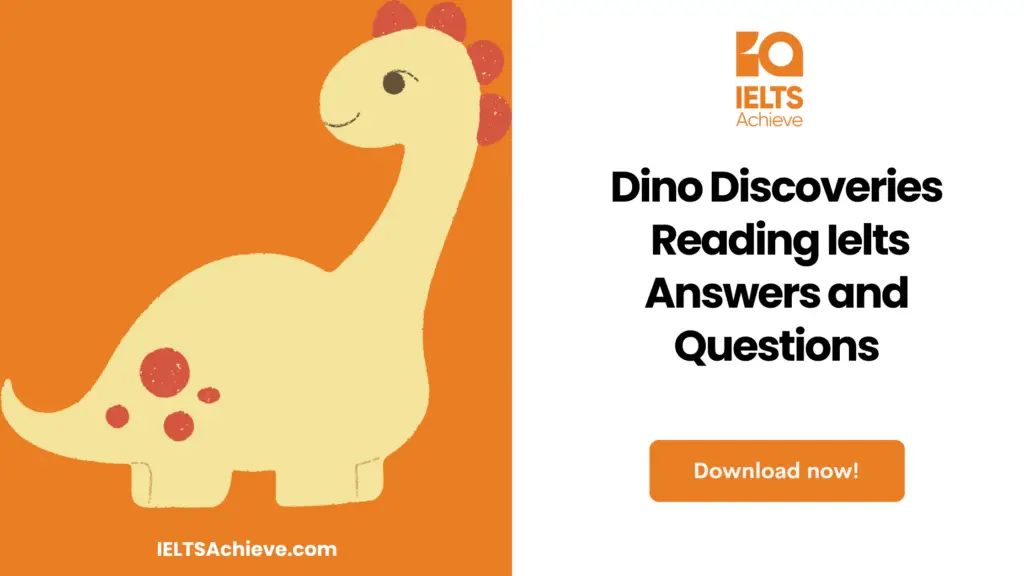The Blog post contains the following IELTS Reading Questions:
- IELTS academic reading diagram labelling
- IELTS Reading True/False/Not given
- IELTS reading multiple choice questions
Stay informed and prepared for success – Explore our comprehensive Reading Test Info page to get valuable insights, exam format details, and expert tips for mastering the IELTS Reading section.
Dino Discoveries Reading Passage

Dino Discoveries
When news comes out about the discovery of a new species of dinosaur, you might be forgiven for assuming that the scientists who headed out in quest of the fossils are the ones who made die find. Cavan Scott dispels the myth and demonstrates how the facts paint a different picture.
The most amazing dinosaurs whose remains have been discovered in the past ten years came to life in the BBC program Planet Dinosaur, thanks to cutting-edge computer graphics. One of these is Gigantoraptor erlianensis, which was found in 2005. It’s the largest dinosaur of its kind, and it’s a bird, measuring almost 3 meters in height from hip to knee. Nevertheless, at that time its discoverer, Xu Xing of Beijing’s Institute of Vertebrate Palaeontology and Paleoanthropology was not even looking for it. In the Gobi Desert in Inner Mongolia, he was gathering footage for a documentary.
Xu explains, “The production crew was recording me and a geologist digging for what we thought were sauropod bones.” ‘ But then I realized the fossils were something else entirely.’ Gigantoraptor, as it ultimately became named, turned out to be an oviraptor, a theropod with a bird-like beak. Its size was astonishing. Previous discoveries of oviraptoridae had only yielded animals roughly the size of turkeys, with the largest being about the size of an emu. Here was a creature that was presumably approximately eight meters long, if the bone analysis was anything to go by.
Occasionally, opportunism plays a role in the discovery of a new species. In 1999, the National Geographic Society claimed to have discovered the missing link between dinosaurs and modern birds. Archaeoraptor liaoningensis is its official name now. The specimen in question looked like a bird from the front, but it had the hind legs and tail of a 124 million-year-old dromaeosaur, a small theropod dinosaur that belonged to the same family as the bird-like Velociraptor made famous in the Jurassic Park movie.
The fossil’s bird-like and dinosaur-like features were intentionally exaggerated for a reason. Almost immediately, CT scans revealed the item to be a fake, the product of an enterprising Chinese farmer who glued two fossils together.
While the palaeontologists responsible for the statement were busy trying to cover their shame, people like Xu took notice. The artificial composite’s head and body belonged to a prehistoric fish-eating bird called Yanornis martini, which lived some 120 million years ago. However, fine proto-feathers coated the dromaeosaur’s tail and hind legs. It turned out to be quite a remarkable fossil. In 2000. Microraptor, Xu’s pet name for it, and its probable past life in the canopy of trees were both disclosed. It couldn’t fly, but the first hard evidence that dinosaurs could have climbed trees was offered by the shape of its curved claws. Three years have passed. The discovery of a new species of Microraptor by Xu and his team shifted the focus. We can say, “Microraptor was notable for two things.” According to Xu, the dinosaur had long feathers on its legs and claws in addition to its forearms. The asymmetry of the vanes on these lengthy feathers drew our attention; this is an attribute commonly connected with the capacity to fly. As a result, it was possible that we had stumbled upon a flying dinosaur.
There are extraordinary fossils that have been ignored for decades because they have been locked up in a collection. The icy tundra of northern Alaska had been overlooked by palaeontologists for most of the 20th century. No way could that have worked, researchers assumed that dinosaurs without warm blood might endure freezing temperatures. However, dinosaur specialist Tony Fiorillo from Alaska claims that they ultimately realized they were missing out.
According to Fiorillo, “a geologist by the name of Robert Liscomb made the first finding of dinosaurs in Alaska in 1961.” Because when Robert perished in a rockslide the next year, his findings were forgotten for 20 years. Managers at the warehouse in the mid-1980s found the box containing Liscomb’s fossils while doing some spring cleaning. The fossilized remains were delivered to the USGS, where they were positively identified as those of the duck-billed hadrosaur Edmontosaurus. Palaeontologists today explore this permafrost-covered time capsule in quest of fossils that have been preserved there.
If you put in the work, you may obtain the advantages. It was discovered through the examination of Troodon’s therapsid teeth that these animals were surprisingly smart. Fiorillo found that the Alaskan Troodon had teeth that were twice as large as those of its southern relative. While the teeth bore some superficial similarities to Troodon, the overall size was far greater than the Troodon of warmer regions. According to Fiorillo, the Troodon’s huge eyes are to blame for this, as they allowed it to hunt at dawn and dusk when other dinosaurs would have had trouble seeing. This ability was particularly valuable in the frigid circumstances of Cretaceous Alaska, where the Sun would disappear for months at a time. Troodon adapted to the unique lighting conditions seen in the arctic regions. That’s why, as Fiorillo argues, it became Alaska’s most commanding therapod.
When the dinosaur realized it was at the top of the food chain, it grew to gigantic sizes to maintain its position there.
The fact that palaeontologists happened to be in the right location at the right time for some of the most astonishing discoveries of the past few decades is in no way indicative of the quality of their work. Remember that not everyone can recognize when they have found something truly exceptional. A petrified tree trunk was discovered in 1988 by Argentine sheep farmer Guillermo Heredia on his Patagonian farm. He had no idea that the 1.5-meter-long tibia belonged to the world’s largest sauropod. The length of an Argentinosaurus was 24 meters, and it weighed 75 tonnes. In 1993, Rodolfo Coria and Jose Bonaparte from the National Museum of Natural History in Buenos Aires were the first to draw attention to the titanosaur. The majority of significant discoveries, Coria argues, are produced not by scientists but by regular people. The true scientific discovery, however, is not the finding itself, but rather the insights gained from the discovery. A fossil can be discovered by anyone, but it takes scientists who are willing to look deeper beyond the surface.
Unlock your full potential in the IELTS Reading section – Visit our IELTS Reading Practice Question Answer page now!
Recommended Questions:
Renewable Energy IELTS Reading Question with Answer
Dino Discoveries IELTS Reading Questions
Questions 1-6
Do the following statements agree with the information in the Reading Passage? Write
- TRUE if the statement agrees with the information
- FALSE if the statement contradicts the information
- NOT GIVEN if there is no information on this
1. Yanomis martini was first found in China, just like Gigantoraptor.
2. The National Geographic Society’s 1999 declaration was supported by incorrect allegations.
3. To look for fossil proof of the existence of Gigantoraptor erlianensis, Xu Xing traveled to the Gobi Desert.
4. Guillermo Heredia had a sneaking suspicion that his find was a fossilized dinosaur.
5. Based on Fiorillo, Troodon’s name translates as “wounding tooth”.
6. Palaeontologists’ perceptions of north Alaska were altered by the bones first found by Robert Liscomb.
Enhance your skills in identifying information as True, False, or Not Given. Click here to discover expert strategies and techniques for mastering this question type in the IELTS Reading section.
Questions 7-13
Complete the labels on the diagrams below.
Choose NO MORE THAN TWO WORDS and/or A NUMBER from the passage for each answer.



Ready to tackle Diagram Label Completion tasks with confidence? Click here to access our comprehensive guide and learn how to accurately label parts or components of diagrams in the IELTS Reading section.
Question 14
Choose the correct letter, A, B, C, or D.
14. In which year, the missing link between dinosaurs and modern birds had been found?
- 1982
- 1986
- 1999
- 2002
Unlock your full potential in the IELTS Reading section – Visit our IELTS Reading Practice Question Answer page now!
Recommended Questions:
Renewable Energy IELTS Reading Question with Answer
Dino Discoveries reading answers
1. Not Given
2. True
3. False
4. False
5. Not Given
6. True
7. Three Meters
8. Bird-Like Beak
9. Curved Claws
10. Asymmetrical Vanes
11. Dusk
12. Warmer
13. Food Chain
14. C

We hope you found this post useful in helping you to study for the IELTS Test. If you have any questions please let us know in the comments below or on the Facebook page.
The best way to keep up to date with posts like this is to like us on Facebook, then follow us on Instagram and Pinterest. If you need help preparing for the IELTS Test, join the IELTS Achieve Academy and see how we can assist you to achieve your desired band score. We offer an essay correction service, mock exams and online courses.

